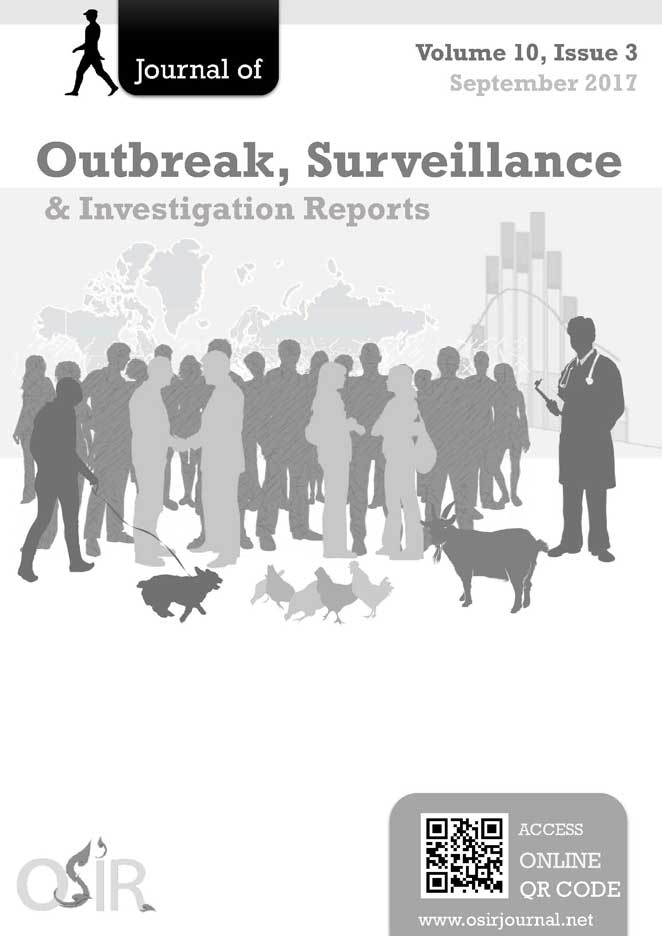Survey of Knowledge, Attitude and Practice Initiated by an Investigation of a Human Rabies Death in Chanthaburi Province, Thailand, 2015
DOI:
https://doi.org/10.59096/osir.v10i3.263085Keywords:
rabies, knowledge, attitude, practice, investigation, ThailandAbstract
In October 2015, one confirmed human rabies case with many human and animal contacts were reported in a subdistrict of Chanthaburi Province. A joint human and animal health team conducted an investigation, including a survey on knowledge, attitude and practice (KAP) in two villages with confirmed animal rabies cases. The human case was scratched at the wrist and bitten at the calf by a stray dog. The wounds were merely washed with rice whisky. However, 77 days later, the case developed myalgia and rash, and thus, visited the subdistrict health promoting hospital. He later died in the provincial hospital. While 22 dogs were suspected for rabies, three of five were tested positive. Members of 149 households and 79 close contacts from the two villages were interviewed. Respondents from both villages had low scores of knowledge, attitude and practice on rabies as well as wound care. Prior to the outbreak, vaccine coverage resulted as 14.8% for owned dogs and 4.2% for cats. The phylogenetic lineage of the rabies virus found in the case was in a group commonly found in Thailand. Poor practice by the case and low KAP scores of the villagers indicated inadequate knowledge about rabies and post-exposure management. The coverage of rabies vaccine among domestic animals in the community was much lower than the requirement of 80%.
References
Hampson K, Coudeville L, Lembo T, Sambo M, Kieffer A, Attlan M, et al. Estimating the global burden of endemic canine rabies. PLoS Negl Trop Dis. 2015 Apr 16;9(4):e0003709. eCollection 2015 Apr.
Department of Disease Control. The strategic plan for rabies free in the country by 2020. 5th ed. Nonthaburi: Uksorn graphic and design; 2013. Thai.
Thailand. Bureau of Epidemiology. Department of Disease Control. Ministry of Public Health. Annual disease surveullance report 2015. 1st ed. Bureau of Epidemiology: Nonthaburi: The Agricultural Co-operative Federation of Thailand, Ltd; 2015. Thai.
World Health Organization. WHO expert consultation on rabies: second report. Geneva: World Health Organization; 2013 [cited 2017 Mar 8]. <http://apps.who.int/iris/bitstream/10665/85346/1/9789240690943_eng.pdf>
Mucheru GM, Kikuvi GM, Amwayi SA. Knowledge and practices towards rabies and determinants of dog rabies vaccination in households: a cross sectional study in an area with high dog bite incidents in Kakamega County, Kenya, 2013. Pan Afr Med J. 2014 Nov 7;19:255. eCollection 2014.
Srisai P, Wongplugsasoong W, Tanprasert S, Sithi W, Thamiganont J, Insea T, et al. Investigation on a dog rabies case and rabid dog meat consumption, Nakhon Phanom Province, Thailand, 2011. OSIR. 2013 Mar;6(1):6-12.
Thailand. Bureau of Epidemiology. Department of Disease Control. Ministry of Public Health. Summary of surveillance report 506 for rabies by year. Thai [cited 2017 Jun 11]. <http://www.boe.moph.go.th/boedb/surdata/disease.php?dcontent=old&ds=42>
Thailand. Department of Livestock Development. Ministry of Agriculture and Cooperatives. Thai Rabies Net. Thai [cited 2017 Jun 11]. <http://www.thairabies.net/trn/Default_Main.aspx>
Centers for Disease Control and Prevention. Epi Info [cited 2017 Mar 23]. <http://wwwn.cdc.gov/epiinfo/html/prevVersion.htm>
Hinjoy S, Tipprat K, Techakamolsook P, editors. Summary of 5 diseases 5 dimensions for surveillance. 1st ed. Nonthaburi: TS Interprint Co. Ltd; 2016. p. 60-9. Thai.
Thailand. Bureau of Epidemiology. Department of Disease Control. Ministry of Public Health. Reported rabies cases and deaths by provinces, Thailand, 2006. Annual disease surveillance report 2006. Thai [cited 2017 Mar 23]. <http://www.boe.moph.go.th/Annual/Annual49/Part2/Annual_MenuPart2.html>
Thailand. Bureau of General Communicable Diseases. Department of Disease Control. Ministry of Public Health. Reporting system for rabies contacts. Thai [cited 2017 Mar 23]. <http://r36.ddc.moph.go.th/r36/home>
Puanghat A, Theerawitthayalert R, Thanacharoenrat N. Knowledge, attitude and practice of Thai people in prevention and control of rabies. Dis Control J. 2010;36(1):50-9. Thai.
Mey C, Metlin A, Duong V, Ong S, In S, Horwood PF, et al. Evidence of two distinct phylogenetic lineages of dog rabies virus circulating in Cambodia. Infect Genet Evol. 2016;38:55-61.
Rupprecht CE, Hanlon CA, Slate D. Control and prevention of rabies in animals: paradigm shifts. Dev Biol (Basel). 2006;125:103-11.
World Health Organization. Regional Office for South-East Asia. Strategic framework for elimination of human rabies transmitted by dogs in the South-East Asia Region. 1st ed. New Delhi: World Health Organization; 2012 [cited 2017 Feb 16]. <http://www.searo.who.int/entity/emerging_diseases/links/Zoonoses_SFEHRTD-SEAR.pdf>
The draft South-East Asia dog rabies elimination strategy. 2013 [cited 2017 Feb 16]. <http://www.rr-asia.oie.int/fileadmin/SRR_Activities/SEA_Rabies_Strategy_-_OIE_Final_Draft.pdf>
Petersen BW, Rupprecht CE. Human rabies epidemiology and diagnosis, non-Flavivirus encephalitis. 2011 [cited 2017 Feb 16]. <https://www.intechopen.com/books/non-flavivirus-encephalitis/human-rabies-epidemiology-and-diagnosis>
Vitasek J. A review of rabies elimination in Europe. Vet Med – Czech. 2004;49(5):171-85.
Downloads
Published
How to Cite
Issue
Section
License
Copyright (c) 2023 Outbreak, Surveillance, Investigation & Response (OSIR) Journal

This work is licensed under a Creative Commons Attribution-NonCommercial-NoDerivatives 4.0 International License.









